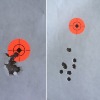One of the funnest things to do is FIND that sweet spot...
Find a nice starting spot with powder and an ACCURATE bullet
Ladder some charges... I do 10-15 of each.. shoot 5... and do it 2-3x in a range day
Chrono/Log them all
Find the best Options... Ladder some more... Rinse and Repeat
Once you find yer sweet spot or spots.. Play with COL and see if it effects the Sweet Spot much... and adjust accordingly
As far as Velocity recording for the Final SWEET SPOT... Not all factors involved
Primer, COL, Powder, Bullet, Barometer, Sun Location, Moon Location, Wind, etc etc etc
But seriously.... Catalogue everything... I just look at what Powder Drop I need for a specific Bullet... set it Up.. Check the COL... and load away
Have fun... dont overthink it too Much.. Unless you can shoot at 1MOE at 300yds+ it really wont matter
Stav
Find a nice starting spot with powder and an ACCURATE bullet
Ladder some charges... I do 10-15 of each.. shoot 5... and do it 2-3x in a range day
Chrono/Log them all
Find the best Options... Ladder some more... Rinse and Repeat
Once you find yer sweet spot or spots.. Play with COL and see if it effects the Sweet Spot much... and adjust accordingly
As far as Velocity recording for the Final SWEET SPOT... Not all factors involved
Primer, COL, Powder, Bullet, Barometer, Sun Location, Moon Location, Wind, etc etc etc
But seriously.... Catalogue everything... I just look at what Powder Drop I need for a specific Bullet... set it Up.. Check the COL... and load away
Have fun... dont overthink it too Much.. Unless you can shoot at 1MOE at 300yds+ it really wont matter
Stav


